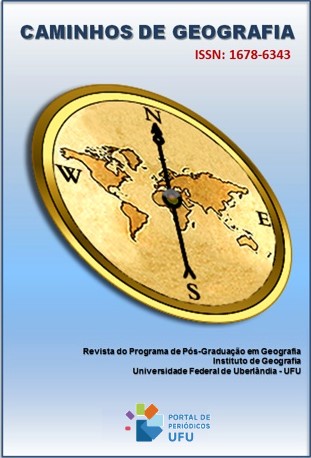PROBABILIDADE DE OCORRÊNCIA DE TEMPERATURAS MÍNIMAS MENSAIS PREJUDICIAIS E FAVORÁVEIS AOS CULTIVOS AGRÍCOLAS EM MINAS GERAIS
DOI:
https://doi.org/10.14393/RCG249365064Palavras-chave:
Séries temporais, Distribuição normal, Redução de riscosResumo
Os objetivos deste trabalho foram verificar o ajuste das séries de dados de temperatura mínima mensal do ar (Tmin), de 47 municípios do Estado de Minas Gerais, às funções de distribuições de probabilidade normal, log-normal, gama e weibull; determinar, para cada série de dados, o valor de Tmin cuja probabilidade de ocorrência de Tmin menor ou igual a esse valor é de 90%; e elaborar mapas com a interpolação desses valores em isolinhas com diferença de 0,5ºC. Nas 564 séries de dados (47 municípios × 12 meses) de Tmin aplicou-se o teste de aderência de Kolmogorov-Smirnov e determinou-se o valor de Tmin cuja probabilidade de ocorrência de Tmin menor ou igual a esse valor é de 90%. Os dados de Tmin se ajustam às distribuições normal, log-normal, gama e weibull. As estimativas dos parâmetros da distribuição normal (média e desvio padrão) podem ser utilizadas para determinar o valor de Tmin cuja probabilidade de ocorrência de Tmin menor ou igual a esse valor é de 90% e, para posterior elaboração de mapas com a interpolação desses valores de Tmin em isolinhas. As isolinhas são úteis para verificar a probabilidade de ocorrência de Tmin prejudicial ou favorável para culturas agrícolas.
Downloads
Downloads
Publicado
Edição
Seção
Licença
Copyright (c) 2023 Rodrigo de Morais Borges, Alberto Cargnelutti Filho, Murilo Vieira Loro

Este trabalho está licenciado sob uma licença Creative Commons Attribution-NonCommercial-NoDerivatives 4.0 International License.
Autores que publicam nesta revista concordam com os seguintes termos: a) Autores mantém os direitos autorais e concedem à revista o direito de primeira publicação, com o trabalho licenciado sob a Creative Commons Atribuição-NãoComercial-SemDerivações 4.0 Internacional. b) Autores têm permissão e são estimulados a publicar e distribuir seu trabalho online (ex.: em repositórios institucionais ou na sua página pessoal), já que isso pode gerar alterações produtivas, bem como aumentar o impacto e a citação do trabalho publicado. c) Em virtude de aparecerem nesta revista de acesso público, os artigos são de uso gratuito, com atribuições próprias, em aplicações educacionais e não-comerciais.











